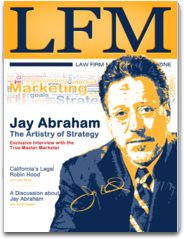
If you are like most lawyers, you have probably used mediation as a means to resolve a legal dispute. Sometimes it can be in your party’s best interest to avoid trial, though there are a lot of times when you might find it difficult to come out as successful as you would’ve liked. Kendall Reed, a contributor with www.NOLO.com, came up with ten simple rules that can help a lawyer be successful with mediation. Take a look at the first five below. They may seem like common sense, but odds are they will help.
- The decision makers must participate.
- The important documents must be physically present.
- Be right, but only to a point.
- Build a deal.
- Treat the other party with respect.
Check out Kendall’s full article, Mediation: Ten Rules for Success, to see the other five rules and to get a more in-depth look at all ten.
Copyright: sakkmesterke









 The keyword lists you generate during the research phase of your Web content strategy are only suggestions of what MAY work. To truly unearth the money-making keywords, you have to evaluate these keywords based on the following three points:
The keyword lists you generate during the research phase of your Web content strategy are only suggestions of what MAY work. To truly unearth the money-making keywords, you have to evaluate these keywords based on the following three points:

